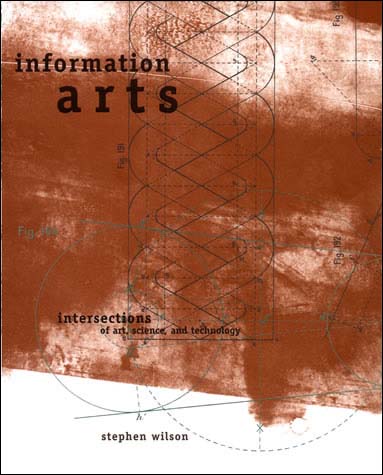Oliver Grau: Virtual Art: From Illusion To Immersion (2001–)
Filed under book | Tags: · art, illusion, immersion, media history, new media, telepresence, virtual art, virtual reality, virtuality

“Although many people view virtual reality as a new phenomenon, it has its foundations in an unrecognized history of immersive images. Indeed, the search for illusionary visual space can be traced back to antiquity. In this book, Oliver Grau shows how virtual art fits into the art history of illusion and immersion. He describes the metamorphosis of the concepts of art and the image and relates those concepts to interactive art, interface design, agents, telepresence, and image evolution. Grau retells art history as media history, helping us to understand the phenomenon of virtual reality beyond the hype.
Grau shows how each epoch used the technical means available to produce maximum illusion. He discusses frescoes such as those in the Villa dei Misteri in Pompeii and the gardens of the Villa Livia near Primaporta, Renaissance and Baroque illusion spaces, and panoramas, which were the most developed form of illusion achieved through traditional methods of painting and the mass image medium before film. Through a detailed analysis of perhaps the most important German panorama, Anton von Werner’s 1883 The Battle of Sedan, Grau shows how immersion produced emotional responses. He traces immersive cinema through Cinerama, Sensorama, Expanded Cinema, 3-D, Omnimax and IMAX, and the head mounted display with its military origins. He also examines those characteristics of virtual reality that distinguish it from earlier forms of illusionary art. His analysis draws on the work of contemporary artists and groups ART+COM, Maurice Benayoun, Charlotte Davies, Monika Fleischmann, Ken Goldberg, Agnes Hegedues, Eduardo Kac, Knowbotic Research, Laurent Mignonneau, Michael Naimark, Simon Penny, Daniela Plewe, Paul Sermon, Jeffrey Shaw, Karl Sims, Christa Sommerer, and Wolfgang Strauss. Grau offers not just a history of illusionary space but also a theoretical framework for analyzing its phenomenologies, functions, and strategies throughout history and into the future.”
This book is a translation of a revised and expanded version of a book entitled Virtuelle Kunst in Geschichte und Gegenwart: Visuelle Strategien, Berlin: Reimer, 2001.
Translated by Gloria Custance
Publisher MIT Press, 2004
Leonardo Books series
ISBN 0262572230, 9780262572231
430 pages
PDF (updated on 2019-10-13)
Comment (0)Stephen Wilson: Information Arts: Intersections of Art, Science, and Technology (2002)
Filed under book | Tags: · art, art and science, artificial intelligence, artistic research, bio art, biology, ecology, electronic art, genetics, interactive media, media art, nanotechnology, new media, physics, robots, science, sound art, technology, telepresence, theory

“A new breed of contemporary artist engages science and technology—not just to adopt the vocabulary and gizmos, but to explore and comment on the content, agendas, and possibilities. Indeed, proposes Stephen Wilson, the role of the artist is not only to interpret and to spread scientific knowledge, but to be an active partner in determining the direction of research. Years ago, C. P. Snow wrote about the “two cultures” of science and the humanities; these developments may finally help to change the outlook of those who view science and technology as separate from the general culture.
In this rich compendium, Wilson offers the first comprehensive survey of international artists who incorporate concepts and research from mathematics, the physical sciences, biology, kinetics, telecommunications, and experimental digital systems such as artificial intelligence and ubiquitous computing. In addition to visual documentation and statements by the artists, Wilson examines relevant art-theoretical writings and explores emerging scientific and technological research likely to be culturally significant in the future. He also provides lists of resources including organizations, publications, conferences, museums, research centers, and Web sites.”
Published by MIT Press, 2002
ISBN 026223209X, 9780262232098
969 pages
PDF (updated on 2012-10-23)
Comment (0)Public Netbase: Non Stop Future. New practices in Art and Media (2008)
Filed under book | Tags: · art, commons, networks, new media, public domain, surveillance, tactical media

The publication is both a review of the pioneer days from the perspective of Public Netbase as well as an outlook into the future of art and culture in digital networks. It provides an overview of a critical information economy discourse, insights into Tactical Media strategies and a critique of the loss of public domain and the commons. Based on the extensive archives of Public Netbase, the book features some of the most spectacular and controversial art projects and interventions from 1994 to 2006. It also offers historical documents and manifestos critical of commercialization and control society issues, together with a view into the digital world of tomorrow.
Sections: Discourse; New Art Practices; Tactical Media; Digital Mediaculture, Networking and Participation; Public Netbase; World-information.org
Editors: Branka Ćurčić, Zoran Pantelić / New Media Center_kuda.org
Editorial team: Konrad Becker, Branka Ćurčić, Zoran Pantelić, Felix Stalder, Martin Wassermair
Publisher Revolver – Archiv für aktuelle Kunst, 2008
ISBN 9783865884558
View online (HTML articles)
Comment (0)
